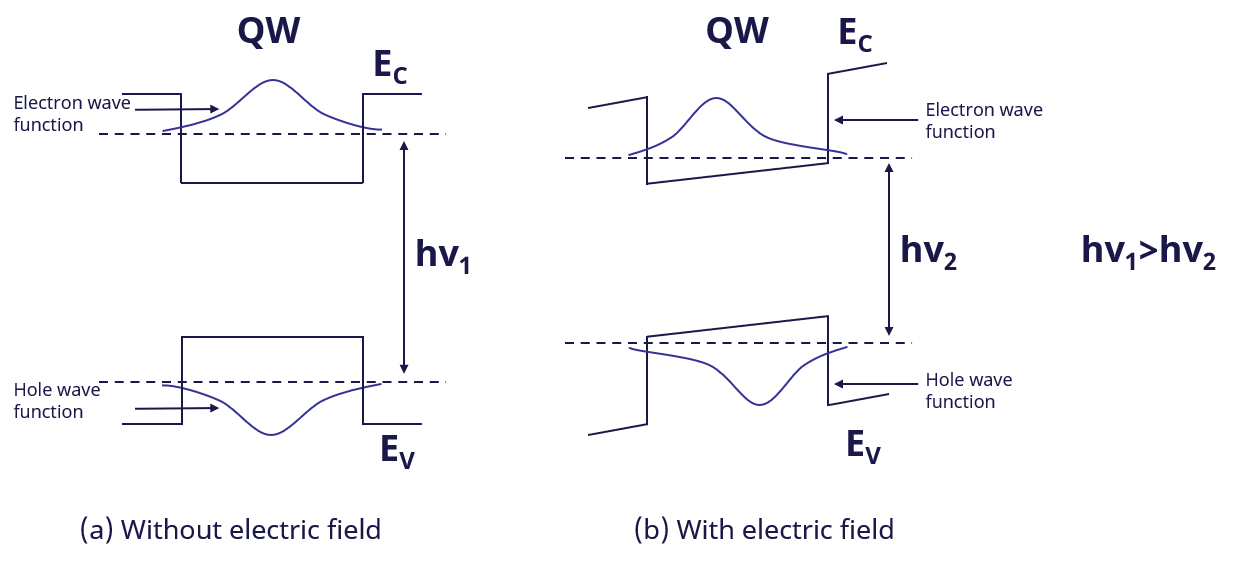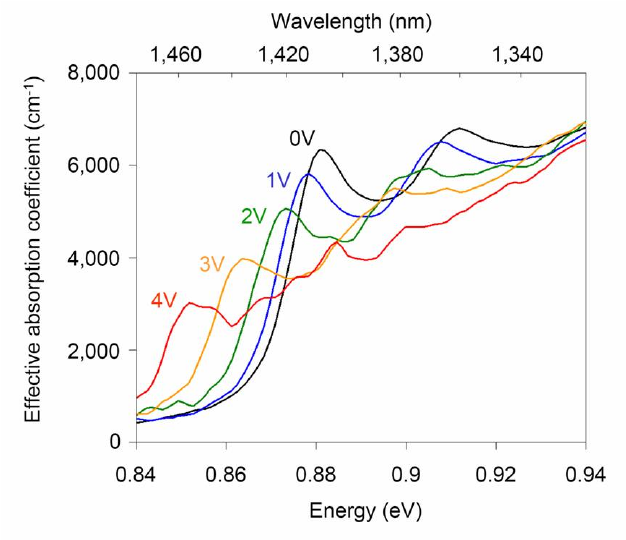1. Electro-Absorption Modulators
The electro-absorption modulator (EAM) is an amplitude modulator that operates by applying an external voltage signal. Its main advantages are a small footprint, low power consumption (hence lower capacitance) and high-speed operation [1]. When an electric field is applied to the active layer in the absorption modulator, it will change the absorption coefficient in the component. As a result, the optical signal in the wavelength band of interest (close to the bandgap) will experience an absorption coefficient change, and hence the intensity of the optical signal will be modulated.
To understand the absorption modulation mechanism we must look into the material’s band diagrams. The schematic of the band diagram is shown in the figure below. For a bulk semiconductor material, applying an external electric field causes the energy bands to tilt. When this happens, photons with energies slightly lower than the bandgap (\(h\nu < E_g\)) can be absorbed because the wavefunction of conduction-band electrons and valence-band holes can tunnel through the bandgap. As the smallest transition energy becomes lower than the bandgap of the material, the absorption edge shifts to longer wavelengths (a red shift). This phenomenon is known as the Franz-Keldysh (FK) effect. The FK has the advantage of a short response time enabling high speed modulation. However, it is a relatively weak effect, exhibiting strong absorption modulation at low temperatures, low optical powers, and it requires high peak-to-peak voltages to operate effectively.

Energy diagram of the bulk semiconductor (a) without electric field and (b) with electric field. When the external field is applied, the smallest transition energy might be smaller than the bandgap [2].
One can enhance the modulation further by utilizing multiple quantum well (MQW) structures in which the Quantum-Confined Stark Effect (QCSE) is present. Energy diagrams are displayed in the figure below. The energy levels are discretized in the quantum well structures and the MQW structure enhances the energy confinement. Thus, an exciton peak appears in the absorption spectrum. When an external electric field is applied, the energy bands tilt, shifting the electron states to lower energies and the hole states to higher energies. This causes a red shift in the absorption spectrum. Additionally, the overlap between the electron and hole transition probability distributions shifts to opposite sides of the well, reducing the recombination efficiency.
The resulting absorption coefficient of the germanium (Ge) MQW applying various reverse biases is demonstrated in the figure below.

Energy diagram of the MQW semiconductor (a) without electric field and (b) with electric field.

Absorption of the Ge based multiple quantum wells under different reverse biases [1]
In this tutorial, we will focus on MQW-based absorption modulators. We use the SiGe alloy for both the well and barrier materials in the MQW structure, as Ge exhibits strong light modulation and detection capabilities. Additionally, Ge can be monolithically integrated into CMOS fabrication processes.